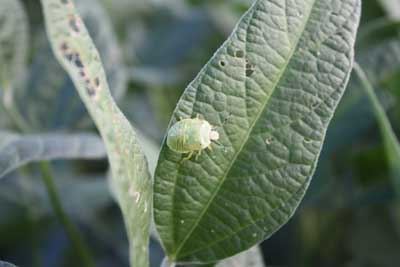Stink Bugs Ramping Up In Soybean
DR. SCOTT STEWART
JACKSON, TENN.
Insect infestations have been generally mild in soybean fields thus far, but as usual, I am starting to get more calls about stink bugs and a few other pests. As other crops mature, including early maturing soybean fields, late season insect populations often concentrate in the remaining soybean fields. Let’s not forget to keep our eyes open. This may include corn earworm infestation in our latest maturing fields.

Stink Bugs are the topic of most calls at this time. Here are a few points to consider.
Populations often start building rapidly at about R5. It really doesn’t matter if you already sprayed a few weeks ago when applying a fungicide. Infestations often continue to build up to and past R7.
Treatment for stink bugs is recommended when you average 9 or more insects per 25 sweeps until R6 (full seed in the top of the plant).
You should double this threshold (18/25 sweeps) in next 7-10 days after fields reach R6.
Treatment is not recommended once fields reach R6 + 7-10 days. At this time, the only possible impact from stink bug infestations is on seed quality, and this should be relatively minor if good IPM practice have been followed up to this point.
Green stink bugs usually compose the vast majority of the stink bugs we find in Tennessee. Pyrethroid insecticides such as Baythroid XL, Brigade and other bifenthrin products, Declare, Karate/Warrior, Mustang Max provide good control of green stink bugs. I would be more inclined to use bifenthrin or Orthene/Acephate if brown stink bugs are usually common.
Like our stink bug threshold, the defoliation threshold in soybean should be relaxed from 20 percent to 30-35 percent once fields reach R6. Making an insecticide application for defoliating pests once you are 7-10 days past R6 is not recommended. It seems obvious, but don’t spray for defoliators if field are beginning to turn color and naturally defoliate.
Maybe I shouldn’t say this, but if you scout a field that is truly at R6 and insect infestations are well below threshold, I often advise people to walk away and don’t look back. The crop really only needs protection for 7-10 more days, and there is only so much that can go wrong. Watching stink bug populations blow up at R7 is irritating even if you can’t justify an insecticide application. ∆
DR. SCOTT STEWART: IPM Extension, University of Tennessee